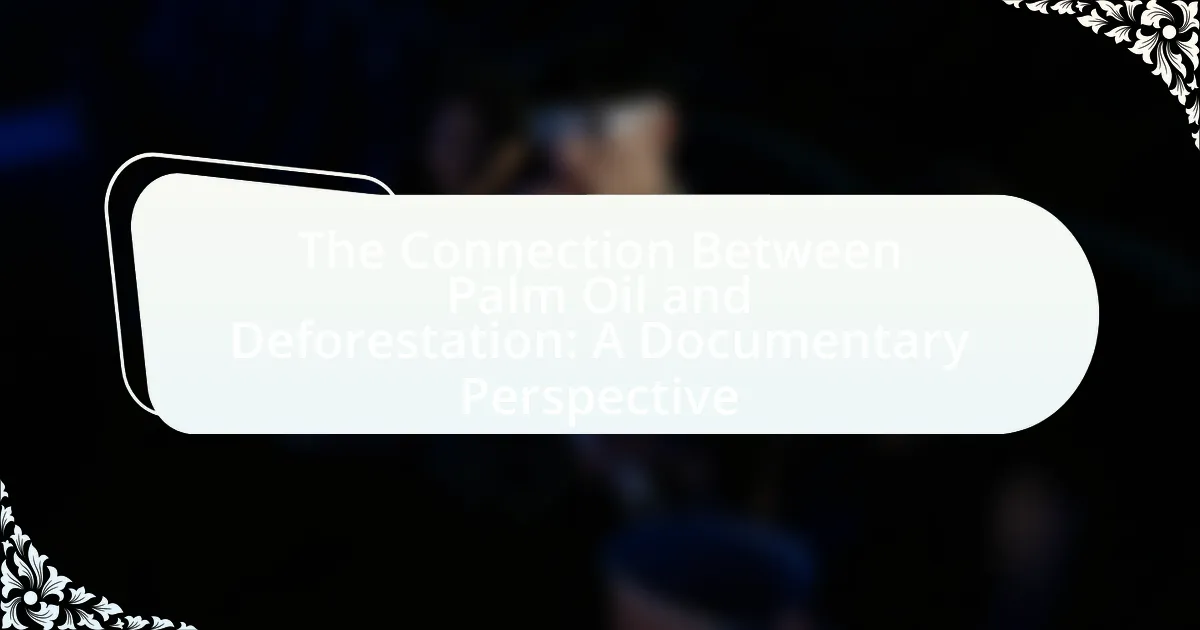The article examines the significant connection between palm oil production and deforestation, particularly in Southeast Asia, where Indonesia and Malaysia are the primary producers. It highlights how the expansion of palm oil plantations leads to extensive forest loss, contributing to biodiversity decline and climate change through carbon emissions. The article discusses the economic factors driving palm oil cultivation, the environmental consequences of deforestation, and the role of consumer demand in shaping agricultural practices. Additionally, it explores the impact of documentaries in raising awareness about these issues and emphasizes the importance of sustainable practices and consumer choices in mitigating deforestation linked to palm oil.

What is the connection between palm oil and deforestation?
The connection between palm oil and deforestation is significant, as the expansion of palm oil plantations is a leading cause of forest loss, particularly in tropical regions like Southeast Asia. Research indicates that approximately 90% of the world’s palm oil is produced in Indonesia and Malaysia, where vast areas of rainforest have been cleared to make way for these plantations. This deforestation not only contributes to biodiversity loss but also exacerbates climate change by releasing stored carbon dioxide into the atmosphere. According to a study published in the journal “Nature,” between 1990 and 2010, palm oil cultivation was responsible for about 6% of global deforestation, highlighting its substantial impact on forest ecosystems.
How does palm oil production contribute to deforestation?
Palm oil production contributes to deforestation primarily through the conversion of forests into palm oil plantations. This process involves clearing vast areas of tropical rainforest, which leads to habitat destruction for countless species and significant loss of biodiversity. According to the World Wildlife Fund, approximately 90% of palm oil is produced in Indonesia and Malaysia, where extensive deforestation has occurred; between 1990 and 2010, Indonesia lost around 6 million hectares of forest due to palm oil expansion. This deforestation not only releases stored carbon dioxide, exacerbating climate change, but also disrupts local ecosystems and indigenous communities reliant on forest resources.
What are the main regions affected by palm oil-related deforestation?
The main regions affected by palm oil-related deforestation are Southeast Asia, particularly Indonesia and Malaysia. These countries have experienced significant forest loss due to the expansion of palm oil plantations, with Indonesia alone losing approximately 1.5 million hectares of forest annually for palm oil production. This deforestation contributes to biodiversity loss and increased greenhouse gas emissions, highlighting the environmental impact of palm oil cultivation in these regions.
What role do agricultural practices play in this connection?
Agricultural practices play a crucial role in the connection between palm oil production and deforestation. Specifically, the expansion of palm oil plantations often leads to significant land clearing, which results in the destruction of forests. For instance, studies indicate that between 1990 and 2010, palm oil cultivation contributed to the loss of approximately 3.5 million hectares of rainforest in Indonesia alone. This deforestation not only threatens biodiversity but also exacerbates climate change by releasing stored carbon dioxide into the atmosphere. Therefore, the methods employed in agricultural practices directly influence the extent of deforestation associated with palm oil production.
Why is palm oil a significant driver of deforestation?
Palm oil is a significant driver of deforestation because its production requires large areas of land, leading to the clearing of forests. In Indonesia and Malaysia, which produce over 85% of the world’s palm oil, millions of hectares of rainforest have been converted into palm oil plantations. This deforestation not only destroys biodiversity but also contributes to greenhouse gas emissions, as the carbon stored in trees is released into the atmosphere. According to a study by the World Wildlife Fund, approximately 1.5 million hectares of forest are lost each year due to palm oil cultivation, highlighting its substantial impact on global deforestation rates.
What economic factors influence palm oil production and deforestation?
Economic factors that influence palm oil production and deforestation include global demand for palm oil, land prices, and government policies. The increasing global demand for palm oil, which is used in food, cosmetics, and biofuels, drives producers to expand plantations, often leading to deforestation. For instance, the global palm oil market was valued at approximately $48.5 billion in 2020 and is projected to grow, incentivizing land conversion. Additionally, the cost of land in tropical regions affects decisions on whether to clear forests for cultivation; lower land prices can encourage deforestation. Furthermore, government policies, such as subsidies for palm oil production or lack of enforcement of environmental regulations, can facilitate the expansion of palm oil plantations at the expense of forests. These economic dynamics create a direct link between palm oil production and deforestation.
How does consumer demand impact palm oil cultivation practices?
Consumer demand significantly influences palm oil cultivation practices by driving the expansion of plantations to meet market needs. As global consumption of palm oil increases, producers often prioritize high-yielding and economically viable practices, which can lead to deforestation and habitat destruction. For instance, the World Wildlife Fund reports that palm oil production has contributed to the loss of over 8 million hectares of rainforest in Indonesia and Malaysia since the 1990s, as producers clear land to establish new plantations. This demand also encourages the adoption of monoculture farming, which can degrade soil health and biodiversity. Thus, consumer preferences directly shape agricultural methods and environmental outcomes in palm oil cultivation.
What are the environmental consequences of palm oil-driven deforestation?
Palm oil-driven deforestation leads to significant environmental consequences, including loss of biodiversity, increased greenhouse gas emissions, and disruption of water cycles. The clearing of tropical forests for palm oil plantations results in habitat destruction for countless species, contributing to the extinction of flora and fauna. For instance, the World Wildlife Fund reports that palm oil expansion threatens species such as orangutans and tigers, which rely on these ecosystems for survival. Additionally, deforestation releases stored carbon dioxide into the atmosphere, exacerbating climate change; studies indicate that land-use changes from palm oil cultivation contribute approximately 10% of global greenhouse gas emissions. Furthermore, the removal of trees disrupts local water cycles, leading to altered rainfall patterns and increased flooding or drought conditions in affected regions.
How does deforestation affect biodiversity in palm oil-producing regions?
Deforestation significantly reduces biodiversity in palm oil-producing regions by destroying habitats essential for various species. The conversion of forests into palm oil plantations leads to habitat fragmentation, which isolates wildlife populations and disrupts their breeding and feeding patterns. For instance, studies indicate that the loss of tropical forests in Southeast Asia has resulted in a decline of over 50% in certain species, such as orangutans and tigers, due to their reliance on these ecosystems for survival. Furthermore, deforestation alters the ecological balance, diminishing the variety of flora and fauna, which can lead to increased vulnerability of ecosystems to diseases and climate change.
What are the implications for climate change due to palm oil-related deforestation?
Palm oil-related deforestation significantly contributes to climate change by releasing large amounts of carbon dioxide into the atmosphere. When forests are cleared for palm oil plantations, the carbon stored in trees is released, exacerbating greenhouse gas emissions. According to a study published in “Nature Climate Change,” deforestation for palm oil production accounts for approximately 10% of global deforestation emissions, which is equivalent to the annual emissions of over 100 million cars. This loss of forest cover not only increases atmospheric CO2 levels but also disrupts local ecosystems and reduces biodiversity, further weakening the planet’s resilience to climate change.

What perspectives do documentaries provide on the palm oil and deforestation issue?
Documentaries provide critical perspectives on the palm oil and deforestation issue by highlighting the environmental, social, and economic impacts of palm oil production. They often showcase the destruction of rainforests, which leads to loss of biodiversity and contributes to climate change, as evidenced by the fact that palm oil plantations are responsible for approximately 10% of global deforestation. Additionally, these films frequently feature the voices of indigenous communities affected by land grabs and displacement, illustrating the human rights violations associated with the industry. Documentaries also explore the complexities of consumer demand and corporate responsibility, emphasizing the need for sustainable practices and ethical sourcing in the palm oil supply chain.
How do documentaries raise awareness about palm oil’s impact on deforestation?
Documentaries raise awareness about palm oil’s impact on deforestation by visually illustrating the environmental consequences of palm oil production. They often showcase the destruction of rainforests, highlighting statistics such as the fact that palm oil plantations have contributed to the loss of over 3 million hectares of forest in Indonesia alone between 1990 and 2015. By featuring interviews with affected communities, environmental activists, and experts, these films provide personal narratives that connect viewers emotionally to the issue. Additionally, documentaries frequently include calls to action, encouraging viewers to make informed choices about palm oil consumption, thereby fostering a greater understanding of its ecological footprint.
What storytelling techniques are commonly used in these documentaries?
Common storytelling techniques used in documentaries about the connection between palm oil and deforestation include personal narratives, expert interviews, and visual storytelling. Personal narratives engage viewers by sharing individual stories of those affected by deforestation, making the issue relatable and emotionally impactful. Expert interviews provide authoritative insights and data, enhancing credibility and informing the audience about the complexities of the palm oil industry. Visual storytelling, through compelling imagery of deforestation and its consequences, captures attention and illustrates the urgency of the issue, effectively conveying the environmental impact. These techniques collectively create a powerful narrative that raises awareness and prompts action regarding palm oil’s role in deforestation.
How do documentaries highlight the voices of affected communities?
Documentaries highlight the voices of affected communities by providing a platform for individuals to share their personal experiences and perspectives on issues such as deforestation linked to palm oil production. Through interviews, storytelling, and visual representation, these films capture the struggles and resilience of communities impacted by environmental changes. For instance, documentaries like “Before the Flood” and “The True Cost” showcase firsthand accounts from local farmers and indigenous people, illustrating the socio-economic and ecological consequences of palm oil cultivation. This approach not only raises awareness but also fosters empathy and understanding among viewers, emphasizing the importance of community voices in discussions about sustainability and environmental justice.
What are some notable documentaries on palm oil and deforestation?
Notable documentaries on palm oil and deforestation include “Before the Flood,” which highlights the environmental impact of palm oil production, and “The True Cost,” which examines the broader implications of consumerism, including palm oil’s role in deforestation. Additionally, “Our Planet” features segments that address the destruction of rainforests for palm oil plantations. These documentaries provide visual evidence and expert commentary on the urgent issues surrounding palm oil and its contribution to deforestation.
What key messages do these documentaries convey?
The key messages conveyed by documentaries on the connection between palm oil and deforestation include the urgent need for sustainable agricultural practices, the environmental impact of palm oil production, and the importance of consumer awareness and responsibility. These documentaries highlight that palm oil cultivation is a leading cause of deforestation, contributing to biodiversity loss and climate change. For instance, the World Wildlife Fund reports that palm oil production has led to the destruction of over 27 million hectares of rainforest, emphasizing the critical need for sustainable sourcing and certification. Additionally, they advocate for informed consumer choices to drive demand for sustainably produced palm oil, thereby reducing the ecological footprint associated with its production.
How have these documentaries influenced public perception and policy?
Documentaries on the connection between palm oil and deforestation have significantly influenced public perception and policy by raising awareness about environmental degradation and promoting sustainable practices. For instance, films like “Before the Flood” and “Our Planet” have highlighted the devastating impact of palm oil production on rainforests, leading to increased public concern and advocacy for sustainable sourcing. This heightened awareness has prompted policymakers in various countries to implement stricter regulations on palm oil imports and promote certification schemes like the Roundtable on Sustainable Palm Oil (RSPO), which aims to reduce deforestation linked to palm oil cultivation. Additionally, consumer behavior has shifted, with more individuals opting for products labeled as sustainably sourced, further pressuring companies to adopt environmentally friendly practices.
What challenges do filmmakers face when addressing palm oil and deforestation?
Filmmakers face significant challenges when addressing palm oil and deforestation, primarily due to the complexity of the issue and the potential backlash from powerful industry stakeholders. The palm oil industry is a multi-billion dollar sector, and filmmakers often encounter resistance from corporations that may threaten legal action or public relations campaigns to discredit their work. Additionally, filmmakers must navigate the intricate socio-economic dynamics of regions affected by deforestation, where local communities may rely on palm oil cultivation for their livelihoods. This complicates the narrative, as filmmakers strive to balance environmental concerns with the economic realities faced by these communities. Furthermore, obtaining accurate data and access to affected areas can be difficult, as many regions are politically sensitive or dangerous due to ongoing conflicts over land use. These factors collectively hinder filmmakers’ ability to create impactful narratives that effectively communicate the urgency of the palm oil and deforestation crisis.
How do political and economic interests affect documentary production?
Political and economic interests significantly influence documentary production by shaping the narratives, funding sources, and distribution channels available to filmmakers. For instance, documentaries addressing controversial topics like palm oil and deforestation often face challenges in securing funding from organizations that may have vested interests in the palm oil industry, which can lead to biased representations or self-censorship. Additionally, political pressures can affect the distribution of documentaries; for example, governments may restrict access to films that critique their policies or economic practices, limiting their reach and impact. This dynamic is evident in the case of documentaries like “Before the Flood,” which faced pushback from industries linked to fossil fuels, illustrating how economic interests can dictate the production and dissemination of critical environmental narratives.
What ethical considerations arise in documenting environmental issues?
Ethical considerations in documenting environmental issues include the accuracy of representation, the potential for exploitation of vulnerable communities, and the responsibility to avoid sensationalism. Accurate representation is crucial to ensure that the complexities of environmental issues, such as the impact of palm oil production on deforestation, are conveyed truthfully. Exploiting vulnerable communities can occur when filmmakers prioritize dramatic narratives over the well-being of those affected, potentially leading to misrepresentation or harm. Additionally, sensationalism can distort public perception and hinder constructive dialogue, as seen in various documentaries that prioritize shocking imagery over nuanced understanding. These considerations highlight the need for ethical standards in environmental documentation to promote informed awareness and responsible storytelling.

How can individuals contribute to addressing the palm oil and deforestation crisis?
Individuals can contribute to addressing the palm oil and deforestation crisis by making informed consumer choices, such as purchasing products certified by the Roundtable on Sustainable Palm Oil (RSPO). By choosing RSPO-certified products, consumers support sustainable practices that minimize deforestation and habitat destruction. In 2020, the World Wildlife Fund reported that sustainable palm oil production can reduce deforestation rates by up to 50% compared to conventional methods. Additionally, individuals can advocate for policies that promote sustainable land use and support organizations working to protect forests. Engaging in awareness campaigns and educating others about the impacts of palm oil can further amplify efforts to combat deforestation.
What actions can consumers take to reduce their impact on palm oil-related deforestation?
Consumers can reduce their impact on palm oil-related deforestation by choosing products that are certified sustainable, such as those bearing the Roundtable on Sustainable Palm Oil (RSPO) label. This certification ensures that palm oil is sourced from plantations that adhere to environmental and social standards, thereby minimizing deforestation. Additionally, consumers can educate themselves about the presence of palm oil in products and opt for alternatives when possible, as palm oil is found in approximately 50% of packaged goods. Supporting brands that commit to zero deforestation policies also contributes to reducing demand for unsustainable palm oil. By making informed purchasing decisions, consumers can significantly influence the market and encourage sustainable practices in the palm oil industry.
How can individuals support sustainable palm oil initiatives?
Individuals can support sustainable palm oil initiatives by choosing products certified by the Roundtable on Sustainable Palm Oil (RSPO). Purchasing RSPO-certified products ensures that the palm oil used is produced in a manner that minimizes environmental impact and promotes social responsibility. In 2020, RSPO reported that over 19 million metric tons of sustainable palm oil were produced, demonstrating a growing commitment to sustainability in the industry. By actively seeking out and purchasing these certified products, individuals contribute to the demand for sustainable practices and help reduce deforestation linked to palm oil production.
What resources are available for consumers to make informed choices?
Consumers can access various resources to make informed choices regarding palm oil and its impact on deforestation. Key resources include educational websites such as the World Wildlife Fund (WWF) and the Rainforest Alliance, which provide detailed information on sustainable palm oil practices and their environmental implications. Additionally, certification programs like the Roundtable on Sustainable Palm Oil (RSPO) offer guidelines and standards for sustainable palm oil production, helping consumers identify responsibly sourced products. Research studies, such as those published in the journal “Environmental Science & Policy,” also provide empirical data on the effects of palm oil cultivation on deforestation, further aiding consumer understanding.
What role do advocacy and education play in combating deforestation linked to palm oil?
Advocacy and education are crucial in combating deforestation linked to palm oil by raising awareness and influencing policy changes. Advocacy groups, such as Greenpeace and the Rainforest Action Network, mobilize public opinion and pressure corporations to adopt sustainable practices, thereby reducing the demand for palm oil sourced from deforested areas. Education initiatives inform consumers about the environmental impacts of palm oil production, leading to more responsible purchasing decisions. For instance, a study by the World Wildlife Fund found that consumer awareness campaigns can significantly decrease the market share of unsustainable palm oil products, demonstrating the effectiveness of advocacy and education in promoting sustainable alternatives.
How can community engagement foster change in palm oil production practices?
Community engagement can foster change in palm oil production practices by empowering local stakeholders to advocate for sustainable methods. When communities are involved in decision-making processes, they can influence practices that prioritize environmental conservation and social responsibility. For instance, initiatives like the Roundtable on Sustainable Palm Oil (RSPO) have shown that involving local communities leads to better compliance with sustainable practices, as evidenced by increased adoption of agroforestry techniques that reduce deforestation rates. Engaged communities can also hold producers accountable, ensuring that they adhere to environmental standards, which ultimately contributes to more sustainable palm oil production.
What are effective strategies for raising awareness about this issue?
Effective strategies for raising awareness about the connection between palm oil and deforestation include educational campaigns, social media engagement, and partnerships with environmental organizations. Educational campaigns can inform the public about the environmental impacts of palm oil production, utilizing statistics such as the fact that palm oil cultivation is responsible for approximately 10% of global deforestation. Social media engagement allows for the rapid dissemination of information and mobilization of support, as platforms like Instagram and Twitter can reach millions with targeted messaging. Collaborating with environmental organizations, such as Greenpeace, can amplify the message and provide credibility, as these organizations often have established networks and resources to effectively advocate for sustainable practices.

Leave a Reply